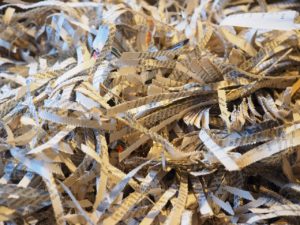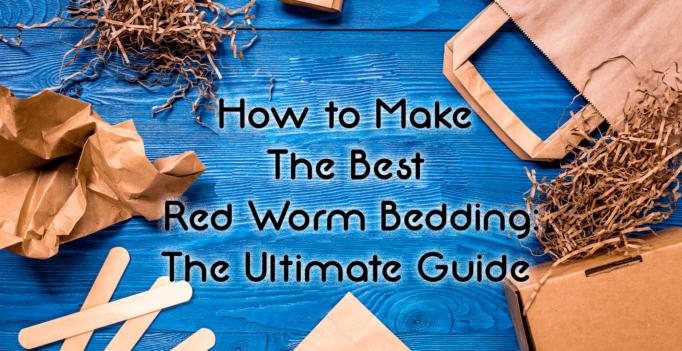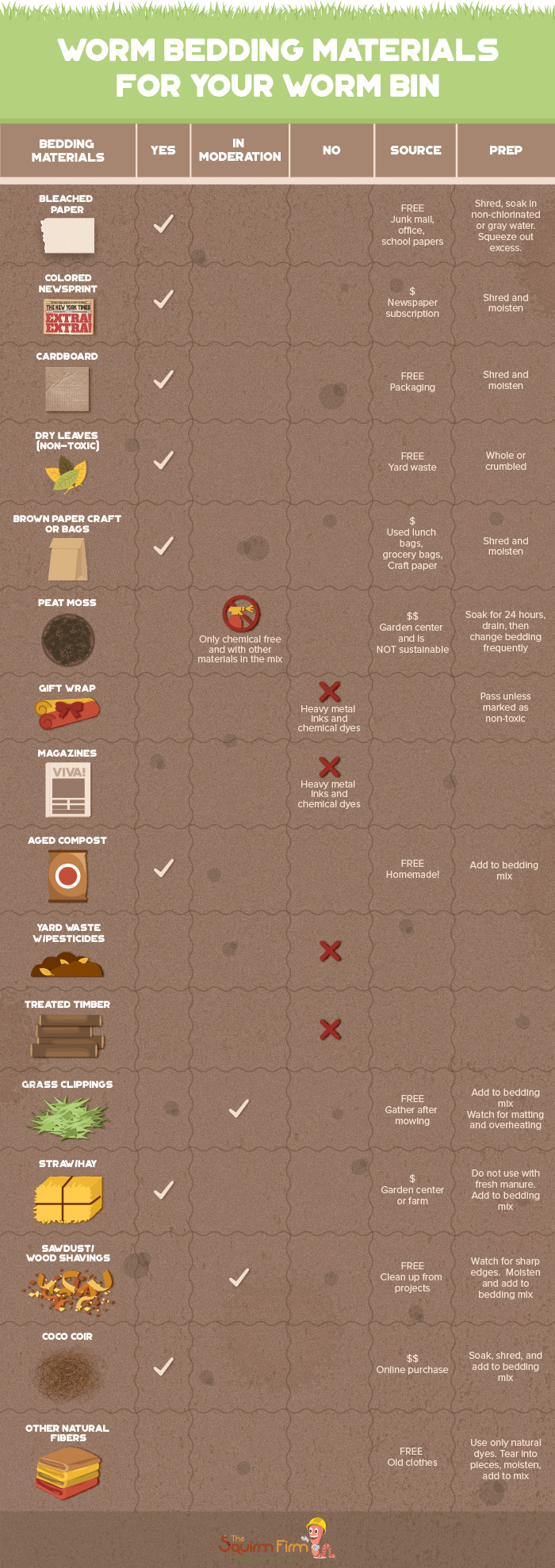Red wiggler compost worms,
You may think they work hard
… but they stay in bed all day!
A common theme has shown up in the comments section of our Facebook page as of late. In particular, our members have asked some great questions about bedding:
”Which bedding is safe?”
”Can I use colored paper for bedding in the worm bin?”
”What is bedding?”
All great questions, thanks for sending those in! We love to help you dig deeper into the finer points of worm composting. So that’s why red wiggler compost bedding is our topic for this month … and it’s a biggie
Who is this for? Everyone who raises worms needs high-quality bedding.
When is this for? Bedding isn’t only for starting out; it needs to be replenished on a consistent and regular basis.
Why does it matter?The quality of your compost bedding is directly tied to the success, growth, and effectiveness of your worm farm.
By the end of this article we’ll more deeply explore each question above PLUS reveal even more about red worm compost bedding materials and procedures:
- Which qualities make good bedding
- What materials to avoid and why
- Which bedding materials are both sustainable and free
- How to prepare bedding mix
Bedding Basics
Once you understand these simple bedding facts, you’ll be off on the right foot.
- Bedding is what makes up the bulk of what we add to our worm compost bins. If you add it to the bin and it isn’t naturally juicy (considered a green), then it’s a brown, and it can be considered bedding.
- Consistently and appropriately moist bedding in the worm bin decomposes aerobically– with the help of billions of bacteria who require oxygen for life. They feed on the organic matter, then become the primary food source for the worms.
- The ideal balance of bedding to food is about 60/40, which means more of the red wiggler’s diet may come from bedding rather than food scraps. And that’s why it’s so important to feel confident about what materials you are using in your worm habitats.
Qualities of Good Bedding Material
Now you may be wondering, “What can I use for worm bedding?” Perfect, just read on to learn which qualities make certain materials work best.

Sustainability
Since you add bedding regularly, and in greater quantity than the food scraps, you can imagine that it requires a consistently renewable resource to make it worth doing.
Luckily, with an endless flow of junk mail and paper packaging these days, you should be able to find your carbon-rich browns pretty easily.
A red wiggler compost worm requires a very humid environment but suffers in overly wet conditions.
Bedding addresses both- it can suck up excess water when necessary, and retains moisture, keeping everything damp, when things are in perfect balance. This method of moisture maintenance also helps to keep temperatures steady in the worm bin.
Aeration
Fluffy bedding creates the foundation for a hospitable habitat in the worm bin. It’s the many tiny air pockets throughout a layer of damp bedding that allow Eisenia fetida to both breathe through their skin and journey from place to place. If bedding is too compact, it doesn’t allow for aeration. That leads to a risk of anaerobic decomposition-which leads to rotting and smells in the worm bin. So, keep it fluffy, my friend, keep it fluffy.
Carbon-based

Simply stated, Wikipedia defines carbon as a key component of all known life on Earth.
The healthy worm farm is home to billions of living creatures who rely on carbon-based morganic matter for food.
These elements sustain life and are transformed into other life-giving things, like fertilizer and the next generation of compost worms!
Beware of Bad Bedding
Some materials in the worm bin will cause undue stress, disease, and even death to your red wigglers. When in doubt, leave it out!
Toxins
This is a point on which many of us get hung up. It’s hard because we often can’t be sure of what makes up the materials we’re choosing! Plus, we can’t always predict the way worms will react to new materials in the bin. It often depends on the maturity of the existing compost, the quantity of bedding added, other materials already in the bin, and the way we process and prepare our materials as bedding.
Some inks in the past were known to contain toxins. And even though most no longer use harmful chemicals, you’re always better safe than sorry, so be sure to read labels, check for toxic/non-toxic symbols, and look to see if there is anything indication that the manufacturer has used soy-based inks.
Commonly, a few materials raise the most red flags … and for good reason:
- Sawdust or wood chips from timber treated to keep insects away have chemicals best left out of the worm bin.
- Cedar, poison oak, poison sumac, and poison ivy all have naturally occurring harmful oils.
- Yard waste with pesticide residue will kill off the bacteria and lead to the demise of the worm bin.
- Bleached paper contains chlorine which may damage delicate worm skin. (See below)
- Highly pigmented colors in glossy magazine pages often contain heavy metals that can build up and poison a worm.
The Good News(paper)
It’s confirmed, newspaper print is now mostly made of soy ink and vegetable dyes, and is not harmful.
A comment posted by Len on the Permaculture Research Institute website claims, “A chemist told me that if you filled an A4 page with colour that the amount of ink would only represent about 1% or so the weight of the paper.“ I found that to be interesting- especially when we consider what fraction of the entire mix of bedding it ends up being. Super tiny.
I use loads of shredded office paper, along with leaves, cardboard, partially composted yard waste, and much more. The combination further reduces any risk of heavy exposure to whatever chemicals may remain. And again, I’ve never seen my worms react other than positively to new bedding, so I feel good stickin’ with it for now.
There’s never a good reason to add shredded paper full of toxic inks and other chemicals to the bin, but I can tell you from experience that there’s a simple way to process it to make it extra safe.
Here’s a step that I use to reduce any risk even further:
“To dechlorinate bleached paper, shred it and allow it to soak in gray water, or even day-old tap water. Just give it a couple of hours and a majority of the chemicals will be gone. Pour off the used water and squeeze out what remains.”
pH Crazy Stuff
PH refers to the acidity, neutrality, or alkalinity of something. Red wigglers require a very stable and neutral pH for optimal health. Using bedding to maintain pH is a quick and easy way to be sure your worm farm is a safe place to be …but not if you use materials like these next two offenders!
Fresh Coffee Grounds
Highly acidic coffee grounds only become problematic when used in such excess that other materials can’t compensate for their low pH. Coffee grounds that have been left to decompose become more neutralized and are then great to add in moderation.
Wood Ash
On the flip side is what the Wormery warns as a highly caustic, alkaline (high pH) material that will burn thinly skinned worms. Wood ash should be kept out of the worm bin entirely.
If you aren’t sure where along the pH scale your bedding materials are, a simple pH meter gives a quick reading that shows if you need to amend your bedding to get it back to neutral.
Sharp Materials
Here, I’m thinking about freshly chipped woods and things like masses of thistle weeds. These would just be treacherous. Pokers, thorns, prickles- these are also very dense compared to the soft green parts of a plant. They break down so slowly that they’d be a long-term source of danger.
Materials that Mat
Materials that tend to mat are things like papers that haven’t been shredded but are wet and packed together. Also, thick layers of leaves may trap moisture and pack so densely that nothing can flow through.
Remember, airflow and drainage are ultra important in a well-managed worm bin. It’s those things in particular that make the Worm Factory 360 such a lifesaver. The holes throughout each layer support ideal conditions. However, if matted bedding closes off the holes, the benefits are lost. When in doubt, use your claw or other accessories to fluff the bedding and regain that oxygen flow your worms need.
Non-absorbent Materials
Aside from being a food source, another vital function of worm compost bedding is to create that ideally moist environment where worms can eat, mate, and lay their cocoons.
Bedding that is light and fluffy is great, but if it is basically dry, it no longer fits the bill. So, keep yours wet enough that it’s like a damp sponge, or near 80% moisture. If you aren’t confident that you can tell by looking, use a moisture meter to get an accurate reading.
As a rule, and one not to be broken, nothing inorganic belongs in the worm bin.
Plastic, glass, metal, and polymers are non-absorbent, non-nutritive, and serve no beneficial purpose as part of the rich fertilizer harvested from a “finished” worm bin. Tear off and discard all tape, gummy glue, plastic labels, stickers, and the little windows you find in some junk-mail envelopes before preparing your worms’ bedding.
DIY Worm Bedding
Here are a few creative examples of how you might go about finding materials for your red worm bedding throughout the year.
Spring: Gather up the dried up remains of last year’s vegetable and cutting garden for a nice carbon-based alternative to shredded paper.
Summer: Husk fresh corn to use both leaves and silks in the bin for volume, aeration, and drainage.
Fall: Mulch dry fallen leaves for an ideal addition to any bedding mix.
Winter: Delivery boxes from UPS, Amazon, etc. are perfect for hungry worms looking for a cozy place to chill.
Note:
Though husks provide the volume and networks of passageways, they do NOT retain water or help with moisture maintenance. Mulched leaves are rich in carbon, microorganisms, and are easily broken down, BUT they are also prone to matting if they are just piled in there as is.
So far, it seems that no single bedding material is likely to have every ideal quality on its own.
To fill in the missing essentials and avoid complications, I combine yard waste (husks, leaves, etc.) with partially finished compost, and *properly prepared junk mail. In this way, beneficial microorganisms, plenty of pockets of air, lasting moisture, and both easily consumable and long-lasting organic matter are all part of the luxury bedding mix.
5 Steps to Prepare Bedding
Sort
When I go through my junk mail, I inevitably have some stuff that I regrettably can’t feed the worms. I pull out the glossy papers, tear out plastic windows on envelopes, and remove things like tape, staples, and wads of glue.
Shred
The smaller bedding bits are, the more easily they can be combined with other materials and be transformed into compost. If it’s an option, I highly recommend using a paper shredder that can handle cardboard or many sheets of paper at a time. Mine has become an indispensable bedding maker!
HINT: Make sure to shred only dry materials. Wet stuff really messes up the shredder!
Soak
This will rid your materials of lingering chemicals and add the moisture red wigglers love.
Strain and Squeeze
Too much water is just as bad as not enough. A salad spinner works well for things that are awkward to squeeze, like wood chips, and other yard waste.
Fluff
After squeezing wet bedding, it often holds together in a tight ball. Break it apart and fluff it up.
Combine
Once the elements of a bedding are made, fold them all together, spread it evenly, and send those happy worms to bed. Voila!
Now it’s your turn!
You can make unique combinations that take advantage of the resources you find in and around your home or workplace. Use any of the materials under the YES column; avoid the ones under NO, and use the In Moderation ones sparingly.
Share this image on your site and please include attribution to The Squirm Firm:
Final Thoughts
The protocol for worm compost bedding is summarized by saying that almost any paper can be safe, except that which is highly glossy, like a magazine cover or certain junk mail postcards.
Generally speaking, the dyes used in most newspaper print are of soy ink and should not be harmful to your compost worms.
Other materials add benefits that paper alone can’t offer. A mix of materials will always be the best.
If you still aren’t sure if you want to add it to your worm bin, ask yourself this, if you don’t let your worms compost it, where will it end up?
For more useful tips, tricks, and expert advice on worm composting, sign up for our FREE monthly newsletter. We’ll keep you in the loop and bring something new to your email inbox once each month.
PS Was this article helpful? Let us know in the comments below.



As a newcomer to this, it is super helpful to see these tips again…. I remember some of what I originally read, but this time I picked up several new sources for bedding and a clearer vision of making my wormies happy campers.
Thanks, Beri! I hope you are finding your worm crew to be loving their custom bedding!
I am starting a bottomless worm farm ,the soil is inside my closed by fensed garden, critter proof, I have lots of worms so I intend to make a bedding area ,and feed them so they will multiple. Any suggestions?
Hi, Melinda. I love the idea you have for starting your new bottomless worm farm. I would just suggest you make sure it’s not in direct sun, gets adequate moisture, and that you can keep track of things like pH and moisture with a simple probe meter. We have them at an affordable price if you don’t have one yet. https://shop.thesquirmfirm.com/worm-compost-ph-moisture-meter/. Otherwise, you can just feed them regularly with approved food scraps, yard waste, and eggshells- it’ll be great! Let us know how the bottomless method works out!
Thanks for all the info. I live in Mexico (interior, not coast) where the temps are fairly stable year-round. My bin will be outside in a shaded area that gets plenty of air circulation. I will be going on vacation for 10 days in September (with shorter trips in between) and am worried about my little wiggly friends while I’m gone. I will have a house-sitter for my cats, but how to best handle my little wiggly friends? Sorry if this is a dumb question, but I’m a noob.
Thanks, Deb. Your question is valid and certainly one we all may need the answer to from time to time. I’m happy to say that your little wiggly friends will be just fine while you are on vacation. Before you leave, just make sure that the moisture content is nice and high- at an appropriate 80% reading on a moisture meter, or as moist as a damp sponge. Give a decent feeding that will last them just long enough for your trip and they’ll be happy. With adequate bedding, moisture, and food, your worms won’t even notice you’ve been gone! Happy travels!
For the bedding of my worm bin I would like to buy a schredder that can handle cardboard and newspaper. All small quantities off course. But all schredder manuals say that the schredder will not schred cardboard nor newspaper. It is really confusing! I see on Youtube videos that people schred easily their stuff for the wormbin.
I suppose that a schredder that can handle 10 pages A4, must be able to schred an Amazon box as well. I would precut the cardboard and the newspaper to a size that is smaller than an A4 page.
Can you give me some advice please?
Hey, Willy! Good thinking. Shredded cardboard is a really sweet bedding ingredient. I’ll tell you that I do use a regular paper shredder to deal with cardboard- but it’s not really easy. You need to tear the boxes up into small enough pieces, then feed them in just a bit at a time – and the machine works hard to get through it. Still, shredders are powerhouses that cut out so much work! I suggest every worm farmer gifts themselves with a shredder!
How many worms should I have in a 18 gallon bin
Hi, Blaise. Thanks for your question. The way to determine an amount of worms for a container has less to do with the volume of the container and more about the surface area you have to work with. Multiply the length by the width of the bin. How many square feet is that? Each square foot can accommodate a full pound of worms. Red wigglers are surface dwellers, so it’s only that very top layer that we consider when figuring this out. So, if your bin is 2 by 3 feet, you would have 6 square feet of living space, and that could hold 6 thousand, or 6 lbs of worms!
Thank you for your helpful information.
I’ve had my worms for about 4 months now.
It’s nearlly the end of Winter and the worms
have been spoiled near the half sunny window.
I give them bananas, vege and egg shells.
They are pumping out little white baby worms
like no tomorrow! I recently gave them some
watermelon and only spring water. All their food goes through a blender
and now I’ve learnt about bedding. Thank You Squirm Firm 🌸
We love to hear of your worm composting success! Keep up the good work! Are you sure those are red wiggler babies? Sometimes in the presence of too much moisture pot worms become an issue. Pot worms remain white where as red wigglers may emerge with a hint of pink.
Nice article. I just wanted to mention one thing that many people don’t realize: *used* coffee grounds are not acidic – they’re nearly neutral pH. The acid is leached into the coffee. 🙂 So you’re safe putting them into the worm bin as is.
hello..from Greece.can I put in worms bin waste from my bokashi bin?
Nikolaos,
You CAN feed bokashi to the worms, however it is fermented (anaerobic), and worms thrive in aerobic condition. From my experience the worms will avoid this stuff for quite a while allowing for aerobic bacteria to colonize it.
Try a small amount in one corner of the bin, giving the worms space to get away from it.
Keep us posted!
I asked my local newspaper (Seattle Times) what type of inks they use and they said the color inks are organic based but the black ink is petroleum based.
Hi!
I’m new to this and I’m super confused about bedding. So, thank you for clearing a lot of that out! I have a question, though: how should I set the bedding in the bin? Should I put a layer of shredded paper, then the partially composted material (if using) and then the food scraps on top? Or should I mix it all up?
Thanks in advance!
Hi Aldana, first let me just set your mind at ease by saying that as long as your moisture and pH levels are good, it’s a little hard to mess this up. I assume you are starting a new bin. If you were to mix your moistened shredded paper (bedding stuff) with partially composted material, you’re off to a good start. Whenever you add food, you can bury it, stick it in a corner, or lay it on top. Lots of people like to lay moistened newspaper over all of it to keep the humidity high and to keep bugs from getting into the food and laying eggs. Once you have a good amount of compost going in there, try not to mix it up very much other than just a few turns for good aeration. Any more questions? Happy to help!
I’m new to worm farming (like 10 days) and struggling to figure out when to add food and bedding to my farm. I have shredded a bunch of cardboard and junk paper and mixed it together (did not soak it). I tried mixing that into my very finely chopped food scraps bin. I have fed the worms from this every few days. They seemed pretty happy before my last addition but a day or so after the addition I’m not seeing as many worms near the top or even down a couple of inches. I’m afraid I have shocked them. The temperature is right around 72 degrees in the center of the bin. I do not have a pH or moisture meter but think I should get one ASAP.
I have noticed a steady progression of other species in the bin. First tiny round white bugs I’m guessing are spider mites which seem to be multiplying. Then a little centipede showed up. Then something else I haven’t identified. I’m guessing these insects came from the garden soil I used for my first bedding mix. I do have wet newspaper on the top and I’m fairly certain no bugs have gotten into the bin. I’m afraid I make too much kitchen waste for the worms to keep up with. When can I add a second tray? I need help!
You are on the right track Cas! Thank you for reaching out. You can find everything you’ll need right here! Yes, definitely grab yourself a pH meter and a moisture meter! Actually, I recommend our combo meter that do it all at once in a matter of seconds.
Now, the worms. You can add a tray as soon as the first one is full. It will take your worms some months yet before they finish that first tray, but it won’t be long before that whole tower is full. However, it would be ideal for you to keep the food in one place for now- so that your worms get together and reproduce rather than explore the tower on their own. You know?
Watch how much food you feed at the start. Make sure you don’t add food until you see the last meal has been completed. Their moist bedding is also a food source, so they won’t go hungry between feedings. Mites often happen when conditions are too moist. Your temperature sounds perfect. Keep at it, very soon the worms practically take care of themselves!
Hi, very useful guide! thx a lot.
I have only one question about bedding.
I’m starting a bin now and inteed to use cardboard, brown paper, fall leaves and aged compost as bedding. Should I mix it all up or should I set the bin in layers of these materials?
Hi Talles. Sounds like you are making a lovely bedding for your worms! I’m glad you asked your question about mixing or layering. And the answer is, it doesn’t matter very much but mixing it will decrease the at the likelihood that your materials will mat together. Also, if there were any issues with any single material, combining them allows those issues to be less intense or problematic. However, in reality, if you were to leave those materials in layers, it would not be too long before the layers would be broken down and mixed by the movement and decomposition aided by the worms. Worm composting is very forgiving and lends itself to fun experimentation!
How often do you need to add new bedding? How will you know it is time? When you do, do you just add it on top or do you mix it in with the current bedding?
Also, should you mix/aerate the bedding, if so how often.
Hi Nina. Great questions. Lot’s of people are wondering the same thing. You can add new bedding whenever you can no longer distinguish the bedding from the worm compost that is accumulating. It’s really never too early to add more, as long as it’s well maintained, but it can be too late- and you would know that if if looks like your worms are just in “mud” rather than a mixture of bedding materials, food, and compost. It’s okay to add moist bedding with every feeding if you like. Or just once in a while. In time, as your worm herd grows, they will consume materials faster than they do now- just because there will be far more of them things move along more quickly. As for mixing or aerating the bedding- it’s okay to loosely aerate just to help your worms get fresh oxygen, but remember in nature there’s no mixing going on- it’s not necessary. I used to do it all the time when I was starting out- but then I learned that every time I would disrupt my worms, I was likely getting in the way of reproduction. I decided then that I’d do less and just make sure to open the lid often enough to get old air out and new air in from the top at least.
Hi Nina. Great questions. Lot’s of people are wondering the same thing. You can add new bedding whenever you can no longer distinguish the bedding from the worm compost that is accumulating. It’s really never too early to add more, as long as it’s well maintained, but it can be too late- and you would know that it looks like your worms are just in “mud” rather than a mixture of bedding materials, food, and compost. It’s okay to add moist bedding with every feeding if you like. Or just once in a while. In time, as your worm herd grows, they will consume materials faster than they do now- just because there will be far more of them things move along more quickly. As for mixing or aerating the bedding- it’s okay to loosely aerate just to help your worms get fresh oxygen, but remember in nature there’s no mixing going on- it’s not necessary. I used to do it all the time when I was starting out- but then I learned that every time I would disrupt my worms, I was likely getting in the way of reproduction. I decided then that I’d do less and just make sure to open the lid often enough to get old air out and new air in from the top at least.
What about the papery skin of onions/garlic?
I’ve never had any issues with them other than the fact that they can take a long time. When they are nice and dry they’ll crumble up nicely and easily be broken down.
Can I use shredded pumpkin seeds to mix in with my normal worm feed?
A well detailed and valuable post. Many thanks for sharing, it’s definitely going to help lots of folks out
there. You always post useful info, some of which I share on Twitter.
Thank you so much for your kind words! We haven’t been able to post new topics at the moment, but please feel free to reach out if you have any questions.
How do you feel about straw as bedding?
Thanks so much!
Hi Laurie!
There is no problem using straw or hay as bedding. It is actually a good option that will give enough airflow in the bin and movement for the worms. But, they don’t hold moisture the same way as paper and cardboard does.
I just signed up for the monthly newsletter. I don’t know when the next one will be out, but could you sent me the most recent one? I just started my little flow through farm and I can’t wait for the information.
Hi Sue,
Unfortunately, we are not able to release a newsletter since November, 2020. Be assured though that you will receive one every month once we start sending out newsletters again.
We have a lot of great worm composting content available on our blog. We invite you to take a look around! If you have any questions, you can always send us an email at contactus@thesquirmfirm.com
Best of luck with your worm composting project.